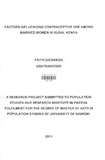| dc.description.abstract | Although knowledge of contraceptive methods is near universal, only 43 percent of women are currently using any modem method. This study analysed the factors influencing use of modem contraceptive methods among 3,620 married women of reproductive age 15-49 years in rural Kenya. It examined socio-economic, socio-cultural, demographic and other intervening factors. The dependent variable in the study is current use of modem methods of contraceptives. The data used was from 2008/2009 KDHS, a nationally representative survey.
Results showed that respondents level of highest education attained, number of children alive, fertility preference and exposure to mass media were highly significant factors influencing use of contraceptives by women in rural Kenya. Logistic regression result did not support the hypothesis that age of the respondent will likely impact the use of modem contraceptive methods in the study area. A policy recommendation was made with a call to the government to focus more effort on improving the education sector specifically to ensure that the effect of subsidized secondary education has a significant effect in improving secondary school enrolment, considering that among the study population only about 20 percent have atleast some secondary education. | en_US |

